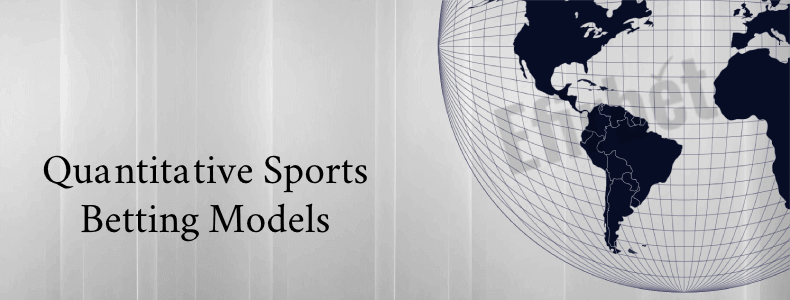Introduction to Quantitative Models for Sports Betting

Whether you’re a hobby-punter or a professional ‘master bettor,’ you’ve probably heard about sports betting models. For many punters, the goal of sports betting isn’t just to make a few bucks/quid by placing wagers on a game. Instead, why not look for ways to make a more consistent profit from your bets, and try relying on systems to do so?! Before we go any further, there’s an important note that we’d like to make. Even though there are quantitative models and betting systems that can improve your chances of winning a bet, there’s no system that will guarantee a win or financial gain. We highly encourage punters to gamble responsibly and to seek help if needed.
With that said, we can move on to the meat of this article: what are quantitative models, and are they sustainable? There are many betting models out there, and not all of them were made equal. In this article, we’ll be taking a closer look at quantitative models for sports betting.
What Are Quantitative Sports Betting Models?
The name might be very confusing, and we can’t argue that quantitative models sound like something complicated, but infallible. After all, if you manage to master something with a name that’s this long, it must work, right?
Not quite.
A quantitative betting model means using a model to quantify the outcome of a wager. Then you must learn how to build a betting strategy around that. In essence, almost all betting models are quantitative because most of them try to determine the most likely outcome of an event. In the same vein, most betting strategies are based on quantitative models, since they all try to predict an event or outcome.
Most of these models make use of significant amounts of research, statistics, and data. If you use them correctly, you can improve your chances of placing winning wagers. That said, these betting models often have incredibly steep learning curves, and aren’t all that easy to master.
If you’ve used a betting strategy before, then chances are that it was based on a type of quantitative betting model.
Pros and Cons
Any betting model, quantitative or otherwise, has its advantages and disadvantages. Each strategy based on these models has its specific pros and cons as well. That said, there are a few traits that many of these models and strategies have in common. We’ve listed some of these below.
You’ll notice that there are several more cons than pros, and that’s because all sports betting strategies carry a degree of risk. The model used to develop them doesn’t matter – there’s always a risk when you go against Lady Luck. However, quantitative models can be challenging to learn and can destroy a bankroll if you make a mistake.
- Pros
- Using these models and strategies are usually 100% legal
- Predictions made with these models are reasonably accurate
- There’s less risk involved using these models if you don’t make mistakes
- High potential profit
- Many online tools and calculators are available for these models
- Cons
- Many quantitative models are incredibly complex and have a steep learning curve
- Punters can easily make costly mistakes
- Bookies don’t appreciate punters using these models and will limit or block accounts that they suspect are using them
- Usually, have smaller profit margins
- Involves a lot of hard work and research
- Punters need an in-depth understanding of their chosen sport, statistical models and math
Risks of Using These Sports Betting Models
There are always risks involved when it comes to gambling online, and there’s no sure way to mitigate those risks 100%. While quantitative betting models do help punters make educated wagers, it’s still just a ‘best guess’ scenario.
Another significant risk with using these sports betting models is their dependency on data. While having accurate and useful statistical data can give excellent results, poor data can ruin a betting strategy. It’s important to know which kind of data to use, and which statistics are qualitative, or based on emotion and opinion, rather than fact.
Many of these models are extremely difficult to use and understand, and if you make a mistake at the bookmakers, it can be extremely costly. Double-check and even triple check your results before you apply the data from a quantitative model to your wagering strategy.
Finally, there’s the most significant risk of all. That’s placing all of your eggs in one basket. Losing everything generally means you’ve made several bad choices. You didn’t manage your bankroll correctly, you wagered too much, and you placed too much faith in your predictive model.
Quantitative Sports Betting Models

Before we get into the strategies, here are a few types of predictive or quantitative models in sports betting. We’ve given a brief overview of two standard quantitative models; many of these models are incredibly complicated, and we can’t go into them in too much detail.
Monte Carlo Simulations
This is probably one of the most common models out there, and it’s used to try and determine the likelihood of an outcome of an event. It uses different mathematical and statistical models, and the more complicated the model, the more knowledge is required. Making use of statistical and historical information, Monte Carlo simulations give probability distributions.
However, Monte Carlo simulations can usually give pretty solid probabilities, which is why so many different strategies use them. There are also many free tools available online that will do the calculations for you.
That said, there’s a big flaw in this model – if you put lousy data in, you’re going to get incorrect data out. If you don’t provide the system with accurate and well-researched information, your results are going to be equally useless.
Poisson Distribution
Poisson distribution is an excellent predictive quantitative model, especially when it comes to sports betting. More specifically, it’s especially useful in sports where points are rare and awarded in single digits. With Poisson distribution, the aim is to predict the outcome of an event by using historical statistics.
By using mean averages and everyday occurrences, punters can use this method to determine the chances of specific events. These percentages can be used to calculate the odds, and the odds can then be applied to different betting strategies.
This is a popular quantitative model, and one of the easier ones to understand. There are also multiple free online tools to help you with the process.
Betting Strategies that Use Quantitative Models
As we’ve mentioned, many different sports betting models can be classified as quantitative betting models. There are also many strategies based on these models. We’ve listed a few of our favourite strategies, as well as a brief overview of how they work.
Back and Lay betting is probably one of the most popular betting strategies used today. It’s also known as Arbitrage betting. Matched betting, on the other hand, uses an arb strategy but combines it with promotional free bet offers from online bookmakers. With this strategy, you place a wager both for and against a certain outcome – a back bet and a lay bet, in other words. To do this, you’ll need to make use of an exchange. As with any wagering strategy, you need to understand that there are risks involved.
For one, bookies don’t like it when you use this kind of strategy. While it’s perfectly legal, they will limit or block your account if they suspect that you’re using arb or matched strategies.
For another, the profits aren’t that notable, but if you make a mistake, you’ll get quite the kick in the pocket. Making a mistake with this strategy can completely wipe out smaller bankrolls, so be careful.
Value betting can be really easy to understand, but there are a few things to take into account before you jump on this bandwagon. While it may be easy to understand, there’s a reason why it’s a favourite amongst experienced punters.
Value betting is intended to give you the edge over your bookie, and that’s not something that happens easily. For value betting to work, you need to be better at calculating probabilities than the bookie. You need to have an in-depth knowledge of the sport you’re wagering on, as well as a thorough understanding of odds and how to calculate them.
It’s no small task.
With value betting, you use available information to calculate your odds. You then compare them to the odds offered by various online bookies. If you find a bookie where the odds are shorter than yours, you’ve probably found a value bet opportunity. That is if you’ve used the right data to do your calculations.
The internet is flooded with different betting strategies and quantitative models that promise ‘guaranteed profits.’ That’s hokum, and there are absolutely no guarantees when it comes to sports betting. However, many of these have one thing in common – they use predictive methods and quantitative models to try and determine outcomes to sporting events.
No rule says that you must use someone else’s model or strategy and pay a small fortune for tools you might never use. You can develop your quantitative betting model, but don’t take this task lightly.
If this is something you’d like to do, remember this:
Some punters spend their whole lives trying to find the ‘perfect’ predictive model and sports betting strategy, but betting will always be a game of chance. Aim for the best possible odds, but don’t expect to develop a foolproof system.
All of the strategies we’ve listed above have their risks, pros, and cons. We can’t recommend the best strategy for you. Instead, it comes down to your personal preference. If you’d rather put in the time and effort to create your model and strategy, then you should feel free to do so.
However, if you prefer to hedge your bets, you might want to make use of a back and lay strategy. More experienced punters know how to calculate their odds and may prefer a value betting strategy.
Find what you’re comfortable with, and then use that. As you get more experienced, you’ll be able to adapt to or try out new sports betting strategies.
Conclusion – Are They Sustainable?
We’ve looked at several elements of quantitative models for sports betting, pros and cons, and a few examples. There are so many different sports betting models and tools, and we simply can’t list them all. That said, the main question here is whether these quantitative models are sustainable or not.
Our answer? Yes and no. It’s going to come down to you as the bettor. These models aren’t a magic wand, and simply giving it a wave isn’t going to fill your bank account. If you want to use these betting models successfully, you’re going to have to make quite a commitment.
We’ve mentioned that quantitative models require a lot of hard work, research, and skill development. However, even if you master these elements of a strategy and use it appropriately, that still doesn’t make it sustainable. If you manage your finances poorly, for example, then you can still lose your entire bankroll.
It comes down to several vital factors. Firstly, don’t rely on a “wonder” strategy to do the work for you. Secondly, make sure that you put in the time and effort to make the model work. Finally, consider external factors. Are you managing your bankroll? Are you taking advantage of bonus offers? Do you place wagers logically or impulsively?
Are quantitative models sustainable? They can be as sustainable as you make them, and as far as luck allows. When it comes to sports betting, that’s about the best we can aim for.
Good luck!

